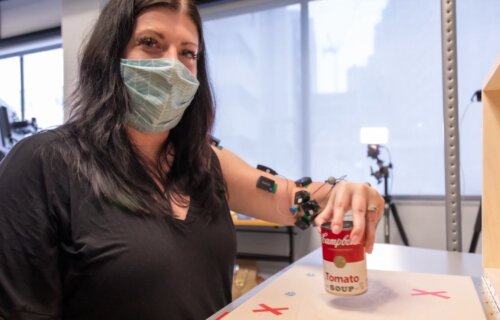PITTSBURGH, Pa. — Stroke victims have new hope of regaining their mobility thanks to scientists in Pittsburgh, who are devising a revolutionary spinal cord stimulation treatment. Patients say the new technology instantly improves their arm and hand mobility, enabling them to conduct their normal daily activities more easily.
The treatment involves implanting a pair of thin metal electrodes — resembling strands of spaghetti — along the neck to engage intact neural circuits. It allows stroke patients to fully open and close their fist, lift their arm above their head, or use a knife and fork to cut a piece of steak for the first time in years.
In a series of tests adapted to individual patients, researchers from University of Pittsburgh Medical Center reveal that the stimulation enables patients to perform a range of complex tasks, ranging from moving a hollow can to opening a lock. Clinical assessments by the research team shows that stimulation targeting cervical nerve roots immediately improves strength, range of movement, and function of the stroke patient’s arm and hand.
The treatment keeps working after the stimulation ends
Surprisingly, the study finds that the effects of stimulation appear to be longer-lasting than the scientists originally predicted. The increased mobility persisted even after removing the device, suggesting that it could world as both an assistive and a restorative method for stroke recovery. The team adds that the immediate effect of the stimulation enables intense physical training that, in turn, may lead to even stronger long-term improvements after the treatment ends.
“We discovered that electrical stimulation of specific spinal cord regions enables patients to move their arm in ways that they are not able to do without the stimulation,” says corresponding and co-senior author Marco Capogrosso, Ph.D., an assistant professor of neurological surgery at Pitt, in a university release.
“Perhaps even more interesting, we found that after a few weeks of use, some of these improvements endure when the stimulation is switched off, indicating exciting avenues for the future of stroke therapies.”
“Thanks to years of preclinical research building up to this point, we have developed a practical, easy-to-use stimulation protocol adapting existing FDA-approved clinical technologies that could be easily translated to the hospital and quickly moved from the lab to the clinic,” Dr. Capogrosso adds.
The treatment could be a cure for ‘permanent’ paralysis
Globally, one in four people over the age of 25 will suffer a stroke in their lifetime, and 75 percent of those will suffer lasting damage to the control of their arms and hands. No treatments are currently effective for treating paralysis in the so-called “chronic” stage, which begins around six months after the stroke. However, researchers say the new technology has the potential to offer hope for people living with disabilities that many doctors might consider permanent.
“Creating effective neurorehabilitation solutions for people affected by movement impairment after stroke is becoming ever more urgent,” says senior co-author Elvira Pirondini, Ph.D., assistant professor of physical medicine and rehabilitation at Pitt.
“Even mild deficits resulting from a stroke can isolate people from social and professional lives and become very debilitating, with motor impairments in the arm and hand being especially taxing and impeding simple daily activities, such as writing, eating and getting dressed.”
Paralysis in the arms can be harder to repair than in the legs
Spinal cord stimulation technology uses a set of electrodes placed on the surface of the spinal cord to deliver pulses of electricity that activate nerve cells inside the spinal cord. The technology is already in use for the treatment of high-grade and persistent pain. Several research groups around the world have shown that spinal cord stimulation can restore movement to the legs after spinal cord injuries.
However, the unique dexterity of the human hand, the wide range of motions the arms and shoulders carry out, and the complexity of the neural signals controlling these limbs, all add a significantly higher set of challenges for stroke recovery. Following years of extensive preclinical studies involving computer modeling and animal testing in macaque monkeys with partial arm paralysis, the researchers in this study received clearance to test this optimized therapy in humans.
“The sensory nerves from the arm and hand send signals to motor neurons in the spinal cord that control the muscles of the limb,” says co-senior author Douglas Weber, Ph.D., professor of mechanical engineering at the Neuroscience Institute at Carnegie Mellon University.
“By stimulating these sensory nerves, we can amplify the activity of muscles that have been weakened by stroke. Importantly, the patient retains full control of their movements: The stimulation is assistive and strengthens muscle activation only when patients are trying to move.”
The team are enrolling further trial participants to understand which stroke patients can benefit most from this therapy and how to optimize stimulation protocols for different severity levels. Scientists are also working to translate the therapy into clinical use.
The findings are published in the journal Nature Medicine.
South West News Service writer Stephen Beech contributed to this report.
